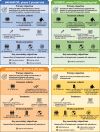NAVIGATOR: a phase 3 multicentre, randomized, double-blind, placebo-controlled, parallel-group trial to evaluate the efficacy and safety of tezepelumab in adults and adolescents with severe, uncontrolled asthma
- PMID: 33050934
- PMCID: PMC7550847
- DOI: 10.1186/s12931-020-01526-6
NAVIGATOR: a phase 3 multicentre, randomized, double-blind, placebo-controlled, parallel-group trial to evaluate the efficacy and safety of tezepelumab in adults and adolescents with severe, uncontrolled asthma
Abstract
Background: Patients with severe, uncontrolled asthma have a significant unmet need for new treatments that have broader effects on airway inflammation, and that provide greater improvements in asthma outcomes than currently approved biologics and standard-of-care therapies. Tezepelumab is a human monoclonal antibody that blocks the activity of the epithelial cytokine thymic stromal lymphopoietin. In the PATHWAY phase 2b study (NCT02054130), tezepelumab significantly reduced exacerbations by up to 71% in adults with severe, uncontrolled asthma, irrespective of baseline disease phenotype. This article reports the design and objectives of the pivotal phase 3 NAVIGATOR study.
Methods: NAVIGATOR (NCT03347279) is an ongoing randomized, double-blind, placebo-controlled trial in adults (18-80 years old) and adolescents (12-17 years old) with severe, uncontrolled asthma, who are receiving treatment with medium- or high-dose inhaled corticosteroids plus at least one additional controller medication with or without oral corticosteroids (N = 1061). The study population includes approximately equal proportions of patients with high (≥ 300 cells/μL) and low (< 300 cells/μL) blood eosinophil counts. The study comprises a 5-6-week screening period, a 52-week treatment period and a 12-week post-treatment follow-up period. All patients will receive their prescribed controller medications without change throughout the study. The primary efficacy endpoint is the annualized asthma exacerbation rate during the 52-week treatment period. Key secondary endpoints include the effect of tezepelumab on lung function, asthma control and health-related quality of life.
Discussion: NAVIGATOR is evaluating the effect of tezepelumab in patients with a broad range of severe asthma phenotypes at baseline, including those with low blood eosinophil counts. The target sample size for NAVIGATOR (N = 1060) was achieved, and it is the largest clinical study of tezepelumab in severe, uncontrolled asthma to date. NAVIGATOR aims to further investigate the effect of tezepelumab on exacerbations and build on observations from the phase 2b PATHWAY study, and to demonstrate further the potential of tezepelumab to provide patients with severe, uncontrolled asthma with improvements in lung function, asthma control and health-related quality of life.
Trial registration: NCT03347279 (ClinicalTrials.gov). Registered 20 November 2017.
Keywords: Clinical trial; Severe asthma; Tezepelumab; Thymic stromal lymphopoietin.
Conflict of interest statement
AMG has: attended advisory boards for AstraZeneca, GlaxoSmithKline, Novartis, Sanofi and Teva; received speaker fees from AstraZeneca, Novartis, Roche and Teva; participated in research with AstraZeneca, for which his institution has been remunerated; attended international conferences with Teva; and consultancy agreements with AstraZeneca, Sanofi and Vectura. GC, JMG, GA, SP, GR, KB, ÅH and EGG are employees of AstraZeneca. PK and MM are employees of Amgen Inc.
Figures




References
-
- Global Asthma Report 2018. http://www.globalasthmareport.org/. Accessed 5 Mar 2020.
Publication types
MeSH terms
Substances
Associated data
LinkOut - more resources
Full Text Sources
Other Literature Sources
Medical

